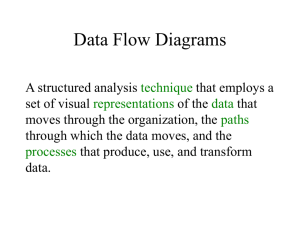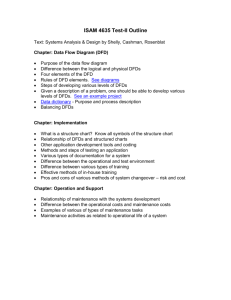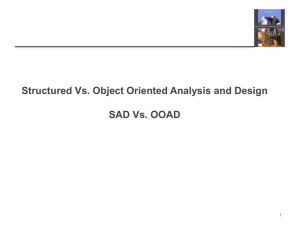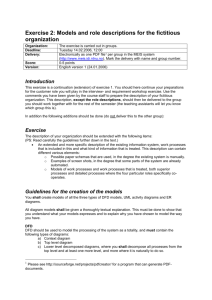Data Flow Diagrams
advertisement
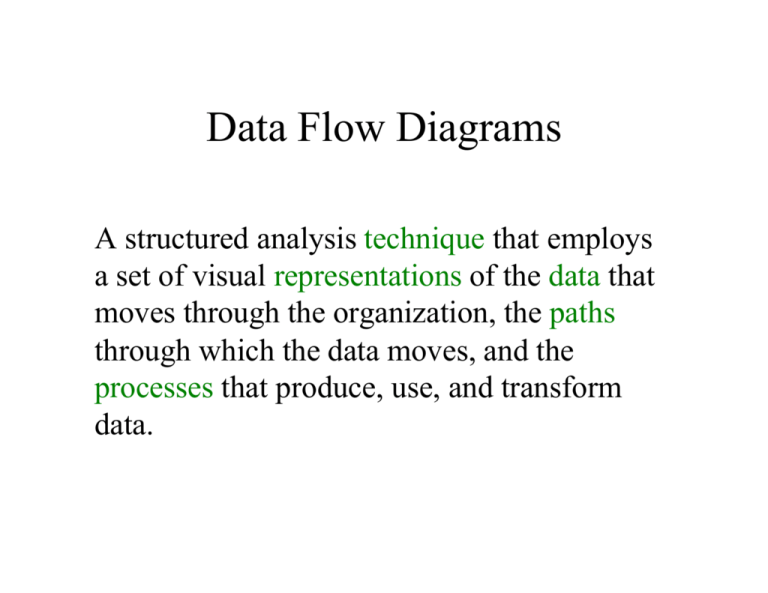
Data Flow Diagrams A structured analysis technique that employs a set of visual representations of the data that moves through the organization, the paths through which the data moves, and the processes that produce, use, and transform data. Why Data Flow Diagrams? • • • • • Can diagram the organization or the system Can diagram the current or proposed situation Can facilitate analysis or design Provides a good bridge from analysis to design Facilitates communication with the user at all stages 2 Types of DFDs • • • • • Current - how data flows now Proposed - how we’d like it to flow Logical - the “essence” of a process Physical - the implementation of a process Partitioned physical - system architecture or high-level design Levels of Detail • Context level diagram - shows just the inputs and outputs of the system • Level 0 diagram - decomposes the process into the major subprocesses and identifies what data flows between them • Child diagrams - increasing levels of detail • Primitive diagrams - lowest level of decomposition Recommended Progression • Current logical diagrams – start with context level – decompose as needed for understanding • Proposed logical diagrams – start at level where change takes place – decompose as far as possible • Current physical diagrams – at level of change • Proposed physical diagrams – same levels as proposed logical – lower levels become design Four Basic Symbols Source/ Sink Data Flow # # Data Store Process Context Level Diagram • Just one process • All sources and sinks that provide data to or receive data from the process • Major data flows between the process and all sources/sinks • No data stores Running Example Course Registration: Context level Diagram Class roster Class Request Student Payment Receipt Professor 0 Course Registration System Student Schedule Enrollment statistics Registrar Level 0 Diagram • Process is “exploded” • Sources, sinks, and data flows repeated from context diagram • Process broken down into subprocesses, numbered sequentially • Lower-level data flows and data stores added Running Example Course Registration: Current Logical Level 0 Diagram Class Request Student Payment Receipt 1.0 2.0 Register Student for Course D1 Student Class Records Student and Course Data Student Class Record Collect Student Fee Student Class Record Payment Payment Information D2 Student Payments Student Class Record Student Class Record 3.0 4.0 5.0 Produce Student Schedule Produce Class Roster Produce Enrollment Report Student Schedule Student Class Roster Professor Enrollment Report Registrar Child Diagrams • “Explode” one process in level 0 diagram • Break down into lower-level processes, using numbering scheme • Must include all data flow into and out of “parent” process in level 0 diagram • Don’t include sources and sinks • May add lower-level data flows and data stores Running Example Course Registration: Current Logical Child Diagram D3 Semester Schedule Available Seats Available Seats 1.1 Class Request Error 1.2 Valid Class Request Check Prerequisites Met 1.3 Feasible Class Check Request for Availability Error Student Record D4 Course Record Student Transcripts D5 Course Catalogue Enroll Student in Class Student and Course Data D1 Student Class Records Physical DFDs • Model the implementation of the system • Start with a set of child diagrams or with level 0 diagram • Add implementation details – indicate manual vs. automated processes – describe form of data stores and data flows – extra processes for maintaining data Running Example Course Registration: Current Physical Child Diagram D3 Semester Schedule DB Available Seats Available Seats 1.1 Class Request 1.2 Check Prerequisites Met Student Notified (manual) Advisement Authorization 1.3 Feasible Class Check for Request Availability (myUMBC) (verbally) Enroll Student in Class (STARS) Unavailability Message Student File Course Description D4 Department Student File D5 Course Catalogue (text) Student and Course Data D1 Semester Enrollment DB Running Example Course Registration: Proposed Physical Child Diagram D3 Semester Schedule DB Available Seats Available Seats 1.1 Class Request Check Prerequisites Met Student Notified (automated) 1.2 Authorized Class Request Check for Availability (automated) 1.3 Valid Class Request (email) Enroll Student in Class (automated) Student Emailed Student Record Course Record D4 Registrar’s Student DB D5 Course Catalogue DB Student and Course Data D1 Semester Enrollment DB Partitioning a physical DFD • Part of system design • System architecture – high-level design – overall shape of system – some standard architectures • Decide what processes should be grouped together in the system components Running Example Course Registration: Physical diagram (partitioned) D3 Semester Schedule DB Available Seats Available Seats 1.1 Class Request Check Prerequisites Met Student Notified (automated) 1.2 Authorized Class Request Check for Availability (automated) 1.3 Valid Class Request (email) Enroll Student in Class (automated) Student Emailed Student Record Course Record D4 Registrar’s Student DB D5 Course Catalogue DB Student and Course Data D1 Semester Enrollment DB Another Example Perfect Pizza: Context Level Diagram Weekly Report Phone Number Customer Customer Order Customer Info Delivery Person Delivery Information Management 0 Customer Order System Cook Order Cook Another Example Perfect Pizza: Current Logical Level 0 Diagram Customer Order Customer Phone Number 1.0 Find Customer Record Customer Info Customer Information Customer Record 2.0 Take Customer Order Order Information Customer History Order Information D2 Customer History D1 Customer Master Customer Record 3.0 Print Delivery Order D3 Sales Records Sales Info 5.0 Add Customer Record Weekly Report Management 7.0 Print Weekly Totals Delivery Information Delivery Person Discount Info 6.0 Send Order to Cook Cook Order Cook Customer Customer Order Another Example Perfect Pizza: Current Logical Child Diagram Customer History Order Information 3.1 Determine Customer Discount D2 Customer History Customer Information 3.2 Record Discount Discount Amount 3.3 Print Delivery Instructions Delivery Information Discount Information D3 Sales Records Another Example Perfect Pizza: Current Logical Child Diagram Customer Information 5.1 Record Customer Information Raw Customer Information 5.2 Store Customer Record Customer Record D1 Customer Master Another Example Perfect Pizza: Physical Child Diagram Syntax Errors Phoned Customer Information Phone Number 5.1 Clerk Types Customer Information D1 Recorded Customer Information Customer DB 5.2 System Validates Customer Information Customer Record Cancelled Transaction Valid Customer Information 5.4 Format Customer Record 5.3 Clerk Visually Confirms Cust. Info. New Customer Information Another Example Perfect Pizza: Current Physical Level 0 Diagram Phoned Customer Order Customer Phone Number 2.0 1.0 Clerk Finds Customer Clerk Takes Customer Information Customer Order Row (by phone) Phoned Customer Info Customer Record Cust. Info. D1Customer Spreadsheet Customer Record Phone # 5.0 Clerk Adds Customer Row Customer & Order Info Copy of Order Slip 3.0 System Prints Delivery Order Customer History Record D2 Customer History DB Delivery Person Delivery Printout Customer History Record 8.0 Mgr Updates Customer History (nightly) Copies of D3 Sales Records File Order Slips & Del. Printouts Copies of Order Slips 7.0 Mgr Prints Weekly Report Weekly Totals (batch) Management Cook Customer Phoned Customer Order 6.0 Clerk Sends Copy of Order order slip to Cook (paper) Another Example Perfect Pizza: Proposed Physical Level 0 Diagram Phoned Customer Order Customer Order Info D3 Sales DB Phone Number Discount Info 2.0 1.0 System Finds Customer Clerk Enters Customer Information Customer Order Record (by phone) Order Customer Info Phoned Cust. Record Customer Info. Info D1 Customer History Record D2 Customer History DB Customer DB Customer Record Phone # Order Info 3.0 System Prints Delivery Order D3 Sales DB Sales Records 5.0 Clerk Adds Customer Record Cook 7.0 System Prints Weekly Report Weekly Totals (batch) Management Delivery Printout Delivery Person Another Example Perfect Pizza: Partitioned Physical Level 0 Diagram Phoned Customer Order Customer Order Info D3 Sales DB Phone Number Discount Info 2.0 1.0 System Finds Customer Clerk Enters Customer Information Customer Order Record (by phone) Order Customer Info Phoned Cust. Record Customer Info. Info D1 Customer History Record D2 Customer History DB Customer DB Customer Record Phone # Order Info 3.0 System Prints Delivery Order D3 Sales DB Sales Records 5.0 Clerk Adds Customer Record Cook 7.0 System Prints Weekly Report Weekly Totals (batch) Management Delivery Printout Delivery Person Data Flow Diagramming Rules • Processes – a process must have at least one input – a process must have at least one output – a process name (except for the context level process) should be a verb phrase • usually three words: verb, modifier, noun • on a physical DFD, could be a complete sentence 1.0 Gather Data 2.0 Demographic Data Survey Responses Compile Statistics 3.0 Analyze Responses Final Report 2.0 Visa Authorization 2.0 BETTER 2.0 Total Records 2.0 BETTER 2.0 QA Process Check Customer Credit Total Sales Records 2.0 BETTER Inspect Finished Products Data Flow Diagramming Rules • Data stores and sources/sinks – no data flows between two data stores; must be a process in between – no data flows between a data store and a source or sink; must be a process in between – no data flows between two sources/sinks • such a data flow is not of interest, or • there is a process that moves that data 2.1 2.1 Customer Information Store Customer Data Customer Data D1 Customer Data Customer Preferences D2 Customer Preferences Customer Information Store Customer Data Customer Data Customer Preferences D1 Customer Data D2 Customer Preferences 2.1 2.1 Customer Information Store Customer Data Customer Data Customer Information Store Customer Data Customer Data D1 Customer Data D1 Customer Data Customer Preferences D2 Customer Preferences Customer Data Customer Preferences 2.2 Extract Customer Preferences D2 Customer Preferences Customer Customer Customer Information 2.0 Customer Data D1 Customer Data Store Customer Data Customer Data D1 Customer Data Doctor Service Information 0 Medical Billing System Diagnosis Patient Bill Data Flow Diagramming Rules • Data flows – data flows are unidirectional – a data flow may fork, delivering exactly the same data to two different destinations – two data flows may join to form one only if the original two are exactly the same – no recursive data flows – data flows (and data stores and sources/sinks) are labelled with noun phrases 1.0 1.0 Take Customer Order Take Customer Order Customer Order Order Total Order Information Order Total Order Information 2.0 3.0 2.0 3.0 Total Daily Sales Print Delivery Instructions Total Daily Sales Print Delivery Instructions 1.0 2.0 1.0 2.0 Take Customer Order Lookup Customer Record Take Customer Order Lookup Customer Record Customer Order Customer Address Customer Order Customer Address Customer Information 3.0 3.0 Print Delivery Instructions Print Delivery Instructions 1.0 Daily Sales Calculate Weekly Sales Cumulative To-Date Sales Data Flow Diagramming Guidelines • The inputs to a process are different from the outputs • Every object in a DFD has a unique name 1.0 Customer Data Validate Customer Data Customer Data 1.0 Customer Data Validate Customer Data Valid Customer Data 1.0 Get Customer Data 2.0 Customer Data 1.0 Get Customer Data Take Customer Order Order Customer Data 2.0 Customer Data Take Customer Order 3.0 Process Customer Order 3.0 Order Process Customer Order 2.0 Customer Data 1.0 Get Customer Data Take Customer Order 3.0 Customer Data Only if these are exactly the same Validate Customer Data Data Flow Diagramming Guidelines • A data flow at one level may be decomposed at a lower level • All data coming into and out of a process must be accounted for • On low-level DFDs, new data flows can be added to represent exceptional situations 1.0 Customer Information Get Customer Address 1.1 Customer Phone Get Customer Phone 1.3 Customer Address Request Customer Address Customer Address 1.2 Customer Phone Lookup Customer Address Customer Address 1.0 Customer Information Get Customer Address 1.1 Customer Phone Invalid Phone Number Message Get Customer Phone 1.3 Customer Address Request Customer Address Customer Address 1.2 Customer Phone Lookup Customer Address Customer Address Data Elements • Indivisible pieces of data • Data flows and data stores are made up of data elements • Like attributes on an ER diagram • The data elements of a data flow flowing in or out of a data store must be a subset of the data elements in that data store Employee D1 Employee Master Employee Record Hours Worked D2 Employee Time File Employee Time Record 1.0 Calculate Gross Pay Gross Pay 2.0 Calculate Withholding Amount Withholding D1 Employee Master Check Reconciliation Record D3 Check Reconciliation Employee Record 4.0 Print Employee Paycheck Net Pay Employee Paycheck Employee 3.0 Calculate Net Pay Employee Hours Worked 5.0 Create Time Record Employee Time Record D2 Employee Time File D4Withholding Tables Number of D1 Employee Master Dependents Withholding Rates Employee Record Employee Time Record 1.0 Calculate Gross Pay Gross Pay 2.0 Calculate Withholding Amount Withholding Amount Gross Pay D1 Employee Master 6.0 Reconcile Pay Check Employee Record Paycheck Information Check Reconciliation Record D3 Check Reconciliation 4.0 Print Employee Paycheck Net Pay Employee Paycheck Employee 3.0 Calculate Net Pay DFDs and ERDs • DFDs and ERDs are both used to model systems, but they show two very different perspectives on the system • A DFD shows what the system does as well as the data that the system manipulates • An ERD shows only the data that the system manipulates. DFDs and ERDs (cont.) • Entities on an ERD often (but not always) correspond to data stores on a DFD • Attributes on an ERD usually correspond to data elements (listed in the data dictionary) that make up the data store and data flows on a DFD • Relationships on an ERD do not correspond to processes on a DFD. • Sources and sinks on a DFD usually do not show up as entities on an ERD Example DFD and ERD Customer DFD 1.0 Places Order Cook Name Customer Name Hours Address Take Order Inventory 2.0 Convert Order to Cooking Instructions 3.0 Processed Order Cooking Instructions Convert Order to Ingredient List Item Quantity Ingredients D1 Order Log Cook Inventory Processing Incorrect ERD Example DFD and ERD OrderId Customer Order DFD Date Contains 1.0 Take Order 2.0 Convert Order to Cooking Instructions Cooking Instructions ItemQuantity Includes Convert Order to Ingredient List Ingredients Requires ItemId Ingredient Ingredient Quantity Item 3.0 Processed Order Time ItemName Index Description Cooking Instructions StepId D1 Order Log Cook Inventory Processing Correct ERD Description
